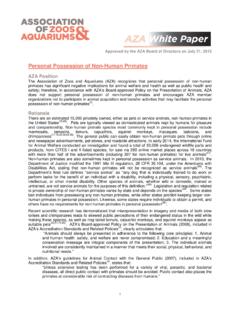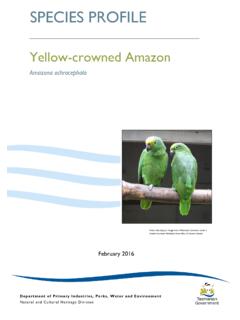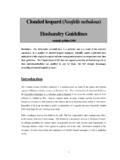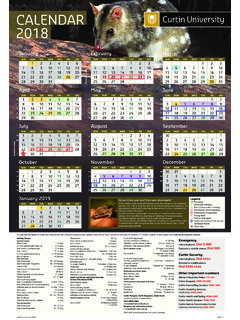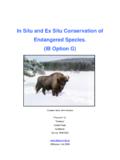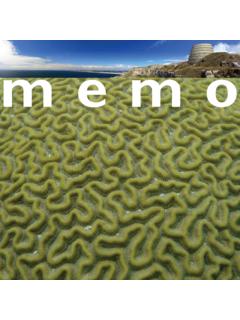Transcription of Rules of Procedure for IUCN Red List Assessments …
1 Rules of Procedure for iucn red list Assessments 2017 2020 Version Citation: IUCN. 2016. Rules of Procedure for iucn red list Assessments 2017 2020. Version Approved by the IUCN SSC Steering Committee in September 2016. Downloadable from: 1 Rules of Procedure for iucn red list Assessments 2017 2020 Version Contents The iucn red list assessment Process Establishment and Appointment of red list Authorities Types of red list Authority red list Authority Roles and Responsibilities The red list Authority Coordinator red list Authority Coordinator Responsibilities Overlapping red list Authority Jurisdictions Resources Nomenclature Annex 1: Required and Recommended Supporting Information for iucn red list Assessments Annex 2: Schematic Illustration of the iucn red list assessment Process Annex 3: Details of the Steps Involved in the iucn red list Process Annex 4: iucn red list assessment Resources Annex 5: Procedure for Handling of Petitions against Current Listings on the iucn red list of threatened SpeciesTM Annex 6: Policy on Use of Pre-Publication iucn red list Data Annex 7.
2 Sensitive Data Access Restrictions Policy for the iucn red list 2 A. The iucn red list assessment Process The iucn red list of threatened Species is produced and managed by the IUCN Species Survival Commission (SSC), the IUCN Global Species Programme and the red list Partnership. In order to maintain the credibility of the iucn red list , the process by which species can be included on the red list has been formalized. In particular, this process includes the designation of red list Authorities (RLAs) and red list Authority Coordinators, under the auspices of the SSC, the responsibilities of which (and whom) are outlined in this document. The iucn red list Unit (RLU) is the gatekeeper to the red list . All Assessments that are published on the red list must be submitted to the RLU. There are three general routes by which Assessments reach the RLU: 1. red list Authorities (RLA).
3 With some exceptions, IUCN SSC Specialist Groups typically are the recognized red list Authorities for the species in their remit. The exceptions are those cases where a red list Partner institution serves as the recognized red list Authority ( , BirdLife International for all birds) or where a stand-alone red list Authority is established (see below). 2. IUCN Global Species Programme and red list Partner projects. These include the global biodiversity Assessments ( , the Global Mammal assessment , Global Marine Species assessment ), and regional biodiversity assessment projects ( , Mediterranean biodiversity Assessments , regional freshwater biodiversity Assessments ) and Assessments for the Sampled red list Index (SRLI) run by the Zoological Society of London and the Royal Botanic Gardens Kew. Assessments submitted via this route must have been formally signed off by the RLA Coordinator of the relevant RLA, where one exists.
4 3. External projects. red list Assessments resulting from projects carried out by individuals, academia, and organizations often outside of the IUCN SSC network (this includes national red list initiatives). Assessments submitted via this route must have been formally signed off by the RLA Coordinator of the relevant RLA, where one exists. All three routes use the same basic process for preparing and submitting Assessments for publication: raw data are gathered and provided by Contributors ; Assessors use the data and the iucn red list Categories and Criteria to assess the taxon, and to document the assessment (as outlined in Annex 1); the assessment is reviewed by at least one Reviewer ; accepted reviewed Assessments are submitted to the RLU for final checks; accepted Assessments are published on the iucn red list .
5 But, the specific activities involved in the process may differ depending on the route used. The steps involved in the iucn red list Process are presented schematically in Annex 2, and these steps are described in more detail in Annex 3. The IUCN SSC Standards and Petitions Sub-Committee (SPSC) and the red list Technical Working Group (RLTWG) also have the right to check Assessments before publication for accurate and consistent application of the iucn red list Categories and Criteria and to check on consistency of approach across taxonomic groups. B. Establishment and Appointment of red list Authorities The Chair of the IUCN Species Survival Commission (SSC) is responsible for the establishment or appointment of red list Authorities according to the types elaborated in section C below. This is done on the approval of the IUCN SSC Steering Committee and in discussion with the IUCN Global Species Programme, the iucn red list Committee and, where applicable, the IUCN SSC Plant Conservation Sub-Committee (PCSC), the IUCN SSC Invertebrate Conservation Sub-Committee (ICSC), the IUCN SSC Freshwater 3 Conservation Sub-Committee (FCSC) and the IUCN SSC Marine Conservation Sub-Committee (MCSC).
6 red list Authorities serve from the time of their appointment until the end of the current IUCN quadrennium (marked by the next meeting of the IUCN World Conservation Congress). Invariably, red list Authorities are automatically re-established by the SSC Chair after Congress, but in some cases they may be discontinued, merged or split. C. Types of red list Authority red list Authorities are not individual people, but are groups of people appointed by the Chair of the SSC to carry out the activities described in these terms of reference for a particular (global or regional) taxonomic grouping of species. There are three types of red list Authority: 1. As noted above, IUCN SSC Specialist Groups typically are the recognized red list Authorities for the species in their remit (for example, the Cat Specialist Group is the red list Authority for all species in the family Felidae).
7 In some cases, Specialist Groups appoint subsets of individuals within the group to form an RLA group. 2. Stand-alone red list Authorities are groups of individuals established only to do Red listing ( , the Brazil Plant RLA is responsible for red list Assessments for all Brazilian plants) 3. An institution serves as the red list Authority ( , BirdLife International is the Bird RLA) D. red list Authority Roles and Responsibilities The roles and responsibilities of the RLA include: a) Establishing mechanisms for assessing and regularly re-assessing species within the RLA s remit and preparing red list Assessments following the iucn red list Categories and Criteria and the Guidelines for Using the iucn red list Categories and Criteria (the latter as may be amended from time to time), using the IUCN Species Information Service (SIS) as the means to compile and submit data; b) Working with the staff of the IUCN Global Species Programme to participate in relevant IUCN SSC global and regional biodiversity assessment processes and, as part of this, populating the SIS with the most up-to-date information available on the species within their remit.
8 C) Serving as the taxonomic authority for species falling into the remit of the RLA (in other words, RLAs are responsible for determining and agreeing the nomenclature used on the iucn red list for the species in that group, noting that RLAs, in turn, are subject to IUCN s own guiding principles on taxonomy, which are currently in preparation and will become an annex to this document once completed). d) The primary responsibility of RLAs is to undertake Assessments at the global level. RLAs have jurisdictional responsibility for deciding the circumstances and conditions under which to undertake Assessments of taxa at the regional and / or national level, noting that resource and other constraints dictate the conditions and circumstances under which such Assessments take place. Even where RLAs do not undertake such Assessments themselves, they may be required to review these Assessments for possible inclusion on the iucn red list .
9 E) The primary responsibility of RLAs is to undertake Assessments at the species level. RLAs have jurisdictional responsibility for deciding the circumstances and conditions under which to undertake Assessments of taxa below the species level, noting that resource and other constraints dictate the conditions and circumstances under which such Assessments take place. Even where RLAs do not undertake such Assessments themselves, they may be required to review these Assessments for possible inclusion on the iucn red list . 4 E. The red list Authority Coordinator For those Specialist Groups appointed as a red list Authority, the SG Chair must recommend to the SSC Chair one person to act as the RLA Coordinator who is then formally appointed to this role by the SSC Chair. The RLA Coordinator will not normally be the same person as the SG Chair, and indeed this is strongly discouraged.
10 For all other RLAs (stand-alone RLAs and institutional RLAs), the Coordinator is directly appointed by the Chair of SSC. The Chair of the SSC may at any time revoke the appointment of an RLA Coordinator. In addition to specific activities listed below, the general responsibilities of the RLA Coordinator include: Overseeing and coordinating red list activities within the RLA; Serving as the contact person between the RLA and the various IUCN and SSC structures including the IUCN Global Species Programme staff, the iucn red list Committee (that oversees the red list process), and the office of the Chair of the SSC. Ensuring that Assessments feed through to the iucn red list Unit in a timely manner, and always at the earliest opportunity, and are not unnecessarily delayed for reasons not related to the assessment process; At the request of the SSC Chair, submitting a short annual report on activities undertaken in the course of the past year for inclusion in the Species Annual Report.

